劳动卫生与环境卫生学硕士科学学位培养方案
国务院学位委员会、教育部关于印发《专业学位研究生教育发展方案(2020-2025)》的通知

国务院学位委员会、教育部关于印发《专业学位研究生教育发展方案(2020-2025)》的通知文章属性•【制定机关】国务院学位委员会,教育部•【公布日期】2020.09.25•【文号】学位〔2020〕20号•【施行日期】2020.09.25•【效力等级】部门规范性文件•【时效性】现行有效•【主题分类】学位管理与研究生教育正文国务院学位委员会教育部关于印发《专业学位研究生教育发展方案(2020-2025)》的通知学位〔2020〕20号各省、自治区、直辖市学位委员会,新疆生产建设兵团学位委员会,军队学位委员会,各研究生培养单位:国务院学位委员会第三十六次会议已审议通过《专业学位研究生教育发展方案(2020-2025)》,现印发给你们,请结合实际认真贯彻执行。
附件:专业学位研究生教育发展方案(2020-2025)国务院学位委员会教育部2020年9月25日附件专业学位研究生教育发展方案(2020-2025)为深入学习贯彻党的十九大和十九届二中、三中、四中全会精神,全面贯彻落实全国教育大会和全国研究生教育会议精神,根据《中国教育现代化2035》和《加快推进教育现代化实施方案(2018-2022年)》,加快推进新时代专业学位研究生教育高质量发展,特制定本方案。
一、成就与挑战专业学位研究生教育是培养高层次应用型专门人才的主渠道。
自1991年开始实行专业学位教育制度以来,我国逐步构建了具有中国特色的高层次应用型专门人才培养体系,为经济社会发展作出重要贡献。
一是完善了我国学位制度,开辟了高层次应用型专门人才的培养通道,实现了单一学术学位到学术学位与专业学位并重的历史性转变。
二是探索建立了以实践能力培养为重点、以产教融合为途径的中国特色专业学位培养模式。
三是培养输送了一大批人才。
截至2019年,累计授予硕士专业学位321.8万人、博士专业学位4.8万人。
四是有力支撑了行业产业发展,针对行业产业需求设置了47个专业学位类别,共有硕士专业学位授权点5996个,博士专业学位授权点278个,基本覆盖了我国主要行业产业,部分专业学位类别实现了与职业资格的紧密衔接。
苏州大学硕士学位研究生培养方案

七、必修环节
必修环节包括文献阅读、学习研讨和学术报 告三方面内容。
文献阅读是硕士研究生培养工作的重要组成 部分,对扩大硕士生的知识面、活跃学术思想、 培养独立工作能力及掌握国内外本学科及相关 学科的动态都有重要意义,也是学位论文选题过 程中不可缺少的环节。硕士研究生必须较广泛地 阅读中文和外文文献。
教师要重视硕士生的文献阅读工作,加强对 文献阅读的指导与考核,文献阅读计2学分。硕 士生在学习期间要做至少两次文献阅读报告, 由 教研室(研究室)组织研究生和有关教师参加, 其中一次可结合学位论文开题报告进行,每次报 交导师。
三、培养方式
1、培养方式实行导师负责和教研室(研究室(所))集体培养相结合。指导教师应教书育人, 引导他们走德、智、体全面发展的道路,硕士生 要虚心学习,积极进取,尊敬师长,教学相长。
2、对硕士生的培养应贯彻课程和论文并重的 原则,硕士生既要学习系统理论,也要进行较深 入的科学研究,特别是要加强研究生综合能力和 素质的培养,包括创新能力、活动能力和适应能 力的培养。
2、掌握本门学科的坚实的理论基础和系统的 专业知识和必要的实践技能;具有从事科学研 究、教学工作或独立担负专门技术工作的能力; 了解本门学科的发展现状和动向,具有实事求 是、严谨的科学作风。
3、熟练掌握一门外国语,能熟练地进行专业 书刊的阅读,并能撰写论文摘要。
4、具有健康的体能。
二、学习年限
硕士研究生的学习年限一般为三年。在职硕 士生的学习年限不超过五年。优秀硕士生提前完 成课程学习和学位论文者,可申请提前答辩和提 前毕业;正常情况下不能按时毕业者作结业处 理;如遇特殊情况,由硕士生本人提出申请,经 导师同意、院长审核、研究生部批准,可延长学 制一年。
四川大学公共卫生学院2016年硕士推免生专业目录_四川大学考研论坛

四川大学公共卫生学院2016年硕士推免生专业目录学科专业代码、专业名称及研究方向导师姓名推免招生人数备注404公共卫生学院40推免招生人数为学院总体预计接收推免生人数办公/通讯地址:成都市人民南路三段16号四川大学华西公共卫生学院卫生管理干部培训中心210室0714Z5生物统计科学学位01生物统计李晓松张菊英张强朱彩蓉冯萍*100401流行病与卫生统计学科学学位01行为流行病学/疾病流行与控制∙栾荣生02慢性病流行病学/传染病流行病学∙袁萍03肿瘤流行病学/分子流行病学∙杨春霞04环境流行病学/疾病防控措施与策略∙李佳圆05慢性病流行病学/分子流行病学∙杨艳芳06流行病学的统计方法∙李晓松∙张菊英∙潘晓平*∙张强∙朱彩蓉∙冯萍*∙杨珉07临床试验的统计方法∙李晓松∙张菊英∙吴艳乔∙朱彩蓉∙冯萍*08卫生政策与管理研究的统计方法∙李晓松∙张菊英∙潘晓平*∙张强∙朱彩蓉∙冯萍*∙杨珉09医学人口统计方法∙张强10卫生信息管理∙吴艳乔100402劳动卫生与环境卫生学科学学位01尘肺/劳动生理与心理健康/职业流行病学∙兰亚佳02环境污染与健康/致癌机制与化疗增敏∙张遵真03环境卫生学∙张浩04职业病防治/尘肺防治∙王晔100403营养与食品卫生学科学学位01食品毒理及保健功能评价/食品安全∙张立实02营养与疾病/食品安全∙李云03营养与疾病/肠道及食品微生物学∙何方04营养流行病学/膳食质量与健康∙成果05特殊人群营养/食品安全∙吕晓华06食品安全∙张建清*07公共营养/妇幼营养/老年营养∙曾果08食物营养与健康∙阴文娅09临床营养/循证营养∙胡雯10营养与疾病/人群营养∙李鸣100404儿少卫生与妇幼保健学科学学位01人群健康影响因素及促进的研究/艾滋病预防∙张建新02儿少卫生学/妇幼保健学/公众健康学∙沈丽琴03出生缺陷干预/妇幼保健∙朱军04儿童营养与健康监测∙王艳萍100405卫生毒理学科学学位01遗传毒理学∙张立实02管理毒理学∙徐培渝03食品毒理学∙黄毅娜1004Z1健康与社会行为学科学学位01健康相关行为研究∙马骁∙周欢02行为与流行病学研究∙周欢03心理健康与健康相关行为研究∙刘巧兰04社会医学/医疗保健制度/社区医学∙李宁秀1004Z2卫生检验与检疫科学学位01卫生理化检验方法及其应用研究∙孙成均∙邹晓莉∙曾红燕02微生物/公众健康与检验∙裴晓方∙许欣∙王国庆∙陈昭斌*∙汪川03传染病防控新技术/疫苗研究及应用∙汪川04分子微生物学与分子消毒学/化妆品卫生学∙陈昭斌*1004Z3老年保健与姑息医学科学学位01老年保健/老年性疾病研究∙熊海02老年保健与营养∙曾果1004Z4卫生政策与管理科学学位01农村卫生政策研究∙刘毅02卫生政策研究/药物及卫生经济评价∙陈丹镝03医药卫生政策研究∙朱梦蓉04卫生经济∙潘杰1004Z5职业卫生与职业医学科学学位01尘肺劳动生理与心理健康职业流行病学∙兰亚佳02职业流行病学/职业中毒∙杨跃林03职业性耳鼻咽喉病∙张晓晴04职业中毒∙赵立强105300公共卫生专业学位01研究方向与学术型专业一致107401社会医学与卫生事业管理科学学位01社会医学/医疗保健制度/社区医学∙李宁秀02健康保险∙汪凯*03西部卫生政策∙马骁04卫生政策与体系研究∙周欢05中国卫生事业管理/卫生人力资源管理∙刘毅06医药产业发展战略∙陈丹镝∙朱梦蓉07医学教育研究与管理/卫生管理∙曾诚∙万学红∙邓洪125200公共管理专业学位01医药卫生政策与监管∙陈丹镝∙朱梦蓉文章来源:文彦考研旗下四川大学考研网。
复旦大学培养研究生学科、专业目录(科学学位)

1998年6月
第七批 124 物理电子学* 080901 1981年11月 1981年11月 125 电路与系统* 080902 1981年11月 1990年11月 126 微电子学与固体电子学* 080903 1981年11月 1997年 127 电磁场与微波技术* 080904 1998年6月 2005年7月 128 光电系统与控制技术(自设专业) 0809Z1 2005年4月 - 工学 信息与通信工程▲
2011年3月 121 光学工程*
(本一级学科国家目录不设二级学科) 080300 2003年5月 2011年3月 材料科学与工程**
2011年3月 122 材料物理与化学* 080501 1990年11月 1998年6月 123 材料学* 080502 2000年12月 2012年6月 理学 电子科学与技术**
自己收集整理的
错误在所难免
仅供参考交流
如有错误
请指正!谢谢
复旦大学培养研究生学科、专业目录(科学学位) (统计至2012年7月) 授予学位
我国全日制公共卫生硕士专业学位培养方案分析
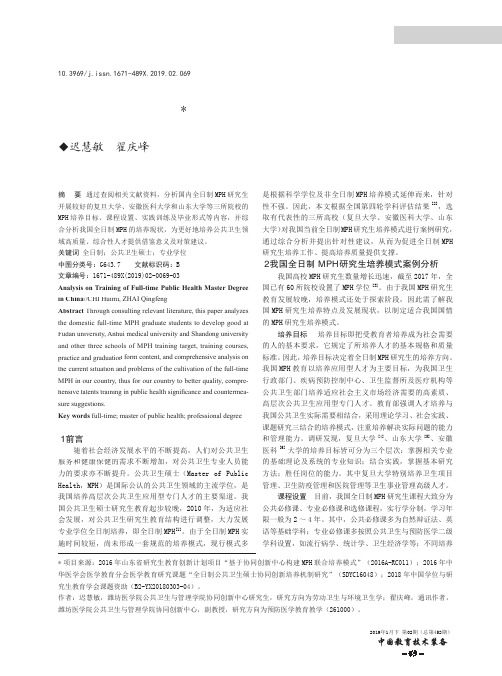
10.3969/j.issn.1671-489X.2019.02.069我国全日制公共卫生硕士专业学位培养方案分析*◆迟慧敏 翟庆峰摘 要 通过查阅相关文献资料,分析国内全日制MPH 研究生开展较好的复旦大学、安徽医科大学和山东大学等三所院校的MPH 培养目标、课程设置、实践训练及毕业形式等内容,并综合分析我国全日制MPH 的培养现状,为更好地培养公共卫生领域高质量、综合性人才提供借鉴意义及对策建议。
关键词 全日制;公共卫生硕士;专业学位中图分类号:G643.7 文献标识码:B 文章编号:1671-489X(2019)02-0069-03Analysis on Training of Full-time Public Health Master Degree //CHI Huimi, ZHAI Qingfeng Through consulting relevant literature, this paper analyzes the domestic full-time MPH graduate students to develop good at Fudan university, Anhui medical university and Shandong university and other three schools of MPH training target, training courses, practice and graduation form content, and comprehensive analysis on the current situation and problems of the cultivation of the full-time MPH in our country, thus for our country to better quality, compre-hensive talents training in public health signifi cance and countermea-sure suggestions.full-time; master of public health; professional degree 随着社会经济发展水平的不断提高,人们对公共卫生服务和健康保健的需求不断增加,对公共卫生专业人员能力的要求亦不断提升。
授予博士、硕士学位和培养研究生的学科、专业目录
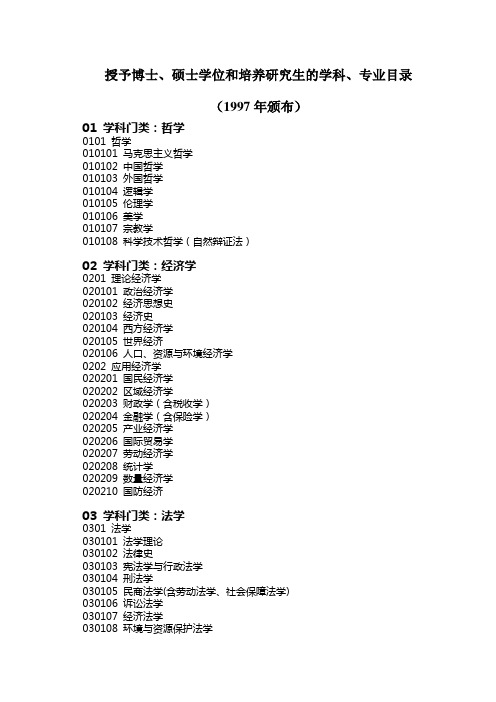
授予博士、硕士学位和培养研究生的学科、专业目录(1997年颁布)01 学科门类:哲学0101 哲学010101 马克思主义哲学010102 中国哲学010103 外国哲学010104 逻辑学010105 伦理学010106 美学010107 宗教学010108 科学技术哲学(自然辩证法)02 学科门类:经济学0201 理论经济学020101 政治经济学020102 经济思想史020103 经济史020104 西方经济学020105 世界经济020106 人口、资源与环境经济学0202 应用经济学020201 国民经济学020202 区域经济学020203 财政学(含税收学)020204 金融学(含保险学)020205 产业经济学020206 国际贸易学020207 劳动经济学020208 统计学020209 数量经济学020210 国防经济03 学科门类:法学0301 法学030101 法学理论030102 法律史030103 宪法学与行政法学030104 刑法学030105 民商法学(含劳动法学、社会保障法学)030106 诉讼法学030107 经济法学030108 环境与资源保护法学030109 国际法学(含国际公法、国际私法、国际经济法) 030110 军事法学0302 政治学030201 政治学理论030202 中外政治制度030203 科学社会主义与国际共产主义运动030204 中共党史(含党的学说与党的建设)030205 马克思主义理论与思想政治教育030206 国际政治030207 国际关系030208 外交学0303 社会学030301 社会学030302 人口学030303 人类学030304 民俗学(含中国民间文学)0304 民族学030401 民族学030402 马克思主义民族理论与政策030403 中国少数民族经济030404 中国少数民族史030405 中国少数民族艺术04 学科门类:教育学0401 教育学040101 教育学原理040102 课程与教学论040103 教育史040104 比较教育学040105 学前教育学040106 高等教育学040107 成人教育学040108 职业技术教育学040109 特殊教育学040110 教育技术学(注:可授予教育学、理学学位)0402 心理学(注:可授予教育学、理学学位)040201 基础心理学040202 发展与教育心理学040203 应用心理学0403 体育学040301 体育人文社会学040302 运动人体科学(注:可授予教育学、理学、医学学位) 040303 体育教育训练学040304 民族传统体育学0501 中国语言文学050101 文艺学050102 语言学及应用语言学050103 汉语言文字学050104 中国古典文献学050105 中国古代文学050106 中国现代文学050107 中国少数民族语言文学050108 比较文学与世界文学0502 外国语言文学050201 英语语言文学050202 俄语语言文学050203 法语语言文学050204 德语语言文学050205 日语语言文学050206 印度语言文学050207 西班牙语语言文学050208 阿拉伯语语言文学050209 欧洲语言文学050210 亚非语言文学050211 外国语言学及应用语言学0503 新闻传播学050301 新闻学050302 传播学0504 艺术学050401 艺术学050402 音乐学050403 美术学050404 艺术设计学050405 戏剧戏曲学050406 电影学050407 广播电视艺术学050408 舞蹈学06 学科门类:历史学0601 历史学060101 史学理论及史学史060102 考古学及博物馆学060103 历史地理学060104 历史文献学(含敦煌学、古文字学) 060105 专门史060106 中国古代史060107 中国近现代史060108 世界史0701 数学070101 基础数学070102 计算数学070103 概率论与数理统计070104 应用数学070105 运筹学与控制论0702 物理学070201 理论物理070202 粒子物理与原子核物理070203 原子与分子物理070204 等离子体物理070205 凝聚态物理070206 声学070207 光学070208 无线电物理0703 化学070301 无机化学070302 分析化学070303 有机化学070304 物理化学(含化学物理) 070305 高分子化学与物理0704 天文学070401 天体物理070402 天体测量与天体力学0705 地理学070501 自然地理学070502 人文地理学070503 地图学与地理信息系统0706 大气科学070601 气象学070602 大气物理学与大气环境0707 海洋科学070701 物理海洋学070702 海洋化学070703 海洋生物学070704 海洋地质学0708 地球物理学070801 固体地球物理学070802 空间物理学0709 地质学070901 矿物学、岩石学、矿床学070902 地球化学070903 古生物学与地层学(含古人类学) 070904 构造地质学070905 第四纪地质学0710 生物学071001 植物学071002 动物学071003 生理学071004 水生生物学071005 微生物学071006 神经生物学071007 遗传学071008 发育生物学071009 细胞生物学071010 生物化学与分子生物学071011 生物物理学071012 生态学0711 系统科学071101 系统理论071102 系统分析与集成0712 科学技术史(注:分学科,可授予理学、工学、农学、医学学位) 08 学科门类:工学0801 力学(注:可授予工学、理学学位)080101 一般力学与力学基础080102 固体力学080103 流体力学080104 工程力学0802 机械工程080201 机械制造及其自动化080202 机械电子工程080203 机械设计与理论080204 车辆工程0803 光学工程0804 仪器科学与技术080401 精密仪器及机械080402 测试计量技术及仪器0805 材料科学与工程080501 材料物理与化学080502 材料学080503 材料加工工程0806 冶金工程080601 冶金物理化学080602 钢铁冶金080603 有色金属冶金0807 动力工程及工程热物理080701 工程热物理080702 热能工程080703 动力机械及工程080704 流体机械及工程080705 制冷及低温工程080706 化工过程机械0808 电气工程080801 电机与电器080802 电力系统及其自动化080803 高电压与绝缘技术080804 电力电子与电力传动080805 电工理论与新技术0809 电子科学与技术(注:可授予工学、理学学位)080901 物理电子学080902 电路与系统080903 微电子学与固体电子学080904 电磁场与微波技术0810 信息与通信工程081001 通信与信息系统081002 信号与信息处理0811 控制科学与工程081101 控制理论与控制工程081102 检测技术与自动化装置081103 系统工程081104 模式识别与智能系统081105 导航、制导与控制0812 计算机科学与技术(注:可授予工学、理学学位)081201 计算机软件与理论081202 计算机系统结构081203 计算机应用技术0813 建筑学081301 建筑历史与理论081302 建筑设计及其理论081303 城市规划与设计(含风景园林规划与设计)081304 建筑技术科学0814 土木工程081401 岩土工程081402 结构工程081403 市政工程081404 供热、供燃气、通风及空调工程081405 防灾减灾工程及防护工程081406 桥梁与隧道工程0815 水利工程081501 水文学及水资源081502 水力学及河流动力学081503 水工结构工程081504 水利水电工程081505 港口、海岸及近海工程0816 测绘科学与技术081601 大地测量学与测量工程081602 摄影测量与遥感081603 地图制图学与地理信息工程0817 化学工程与技术081701 化学工程081702 化学工艺081703 生物化工081704 应用化学081705 工业催化0818 地质资源与地质工程081801 矿产普查与勘探081802 地球探测与信息技术081803 地质工程0819 矿业工程081901 采矿工程081902 矿物加工工程081903 安全技术及工程0820 石油与天然气工程082001 油气井工程082002 油气田开发工程082003 油气储运工程0821 纺织科学与工程082101 纺织工程082102 纺织材料与纺织品设计082103 纺织化学与染整工程082104 服装设计与工程0822 轻工技术与工程082201 制浆造纸工程082202 制糖工程082203 发酵工程082204 皮革化学与工程0823 交通运输工程082301 道路与铁道工程082302 交通信息工程及控制082303 交通运输规划与管理082304 载运工具运用工程0824 船舶与海洋工程082401 船舶与海洋结构物设计制造082402 轮机工程082403 水声工程0825 航空宇航科学与技术082501 飞行器设计082502 航空宇航推进理论与工程082503 航空宇航制造工程082504 人机与环境工程0826 兵器科学与技术082601 武器系统与运用工程082602 兵器发射理论与技术082603 火炮、自动武器与弹药工程082604 军事化学与烟火技术0827 核科学与技术082701 核能科学与工程082702 核燃料循环与材料082703 核技术及应用082704 辐射防护及环境保护0828 农业工程082801 农业机械化工程082802 农业水土工程082803 农业生物环境与能源工程082804 农业电气化与自动化0829 林业工程082901 森林工程082902 木材科学与技术082903 林产化学加工工程0830 环境科学与工程(注:可授予工学、理学、农学学位)083001 环境科学083002 环境工程0831 生物医学工程(注:可授予可授工学、理学、医学学位)0832 食品科学与工程(注:可授予工学、农学学位)083201 食品科学083202 粮食、油脂及植物蛋白工程083203 农产品加工及贮藏工程083204 水产品加工及贮藏工程09 学科门类:农学0901 作物学090101 作物栽培学与耕作学090102 作物遗传育种学0902 园艺学090201 果树学090202 蔬菜学090203 茶学0903 农业资源利用学090301 土壤学090302 植物营养学0904 植物保护学090401 植物病理学090402 农业昆虫与害虫防治090403 农药学(注:可授予农学、理学学位)0905 畜牧学090501 动物营养与饲料科学090502 动物遗传育种与繁殖090503 草业科学090504 特种经济动物饲养(含蚕、蜂等)0906 兽医学090601 基础兽医学090602 预防兽医学090603 临床兽医学0907 林学090701 林木遗传育种学090702 森林培育学090703 森林保护学090704 森林经理学090705 野生动植物保护与利用090706 园林植物及观赏园艺090707 水土保持与荒漠化防治0908 水产学090801 水产养殖学090802 捕捞学090803 渔业资源学10 学科门类:医学1001 基础医学100101 人体解剖与组织胚胎学100102 免疫学100103 病原生物学100104 病理学与病理生理学100105 法医学100106 放射医学100107 航空、航天与航海医学1002 临床医学100201 内科学(含心血管病学、血液病学、呼吸系病学、消化系病学、内分泌与代谢病学、肾脏病学、风湿病学、传染病学)100202 儿科学100203 老年医学100204 神经病学100205 精神病与精神卫生学100206 皮肤病与性病学100207 影像医学与核医学100208 临床检验诊断学100209 护理学100210 外科学(含普通外科学、骨外科学、泌尿外科学、胸心血管外科学、神经外科学、整形外科学、烧伤外科学、野战外科学)100211 妇产科学100212 眼科学100213 耳鼻咽喉科学100214 肿瘤学100215 康复医学与理疗学100216 运动医学100217 麻醉学100218 急诊医学1003 口腔医学100301 口腔基础医学100302 口腔临床医学1004 公共卫生与预防医学(注:可授予医学、理学学位) 100401 流行病与卫生统计学100402 劳动卫生与环境卫生学100403 营养与食品卫生学100404 儿少卫生与妇幼保健学100405 卫生毒理学100406 军事预防医学1005 中医学100501 中医基础理论100502 中医临床基础100503 中医医史文献100504 方剂学100505 中医诊断学100506 中医内科学100507 中医外科学100508 中医骨伤科学100509 中医妇科学100510 中医儿科学100511 中医五官科学100512 针灸推拿学100513 民族医学1006 中西医结合医学100601 中西医结合基础医学100602 中西医结合临床医学1007 药学(注:可授予医学、理学学位)100701 药物化学100702 药剂学100703 生药学100704 药物分析学100705 微生物与生化药学100706 药理学1008 中药学11学科门类:军事学1101 军事思想学及军事历史学110101 军事思想学110102 军事历史学1102 战略学110201 军事战略学110202 战争动员学1103 战役学110301 联合战役学110302 军种战役学(含第二炮兵战役学)1104 战术学110401 合同战术学110402 兵种战术学1105 军队指挥学110501 作战指挥学110502 军事运筹学110503 军事通信学110504 军事情报学110505 密码学110506 军事教育训练学(含军事体育学)1106 军制学110601 军事组织编制学110602 军队管理学1107 军队政治工作学1108 军事后勤学与军事装备学110801 军事后勤学110802 后方专业勤务110803 军事装备学12学科门类:管理学1201 管理科学与工程(注:可授予管理学、工学学位)1202 工商管理学120201 会计学120202 企业管理学(含财务管理、市场营销、人力资源管理)120203 旅游管理学120204 技术经济及管理学1203 农林经济管理学120301 农业经济管理学120302 林业经济管理学1204 公共管理学120401 行政管理学120402 社会医学与卫生事业管理学(注:可授予管理学、医学学位) 120403 教育经济与管理学(注:可授予管理学、教育学学位) 120404 社会保障学120405 土地资源管理学1205 图书馆、情报与档案管理学120501 图书馆学120502 情报学120503 档案学。
苏州大学硕士学位研究生培养方案

苏州大学硕士学位研究生培养方案一、培养目标培养面向现代化、面向世界、面向未来,在国民经济建设、科学技术发展和社会进步中发展积极作用的具有创新精神的复合型的科学研究人才、工程技术人才、高级管理人才和高等学校师资。
具体要求如下:1、努力学习马列主义、毛泽东思想和邓小平理论,成为有道德、有理想、有文化、有纪律的年轻一代;能够运用马克思主义的观点和方法分析问题、解决问题;拥护党的基本路线、方针和政策;热爱祖国,遵纪守法,品行端正,具有良好的职业道德,积极为我国的社会主义建设服务。
2、掌握本门学科的坚实的理论基础和系统的专业知识和必要的实践技能;具有从事科学研究、教学工作或独立担负专门技术工作的能力;了解本门学科的发展现状和动向,具有实事求是、严谨的科学作风。
3、熟练掌握一门外国语,能熟练地进行专业书刊的阅读,并能撰写论文摘要。
4、具有健康的体能。
二、学习年限硕士研究生的学习年限一般为三年。
在职硕士生的学习年限不超过五年。
优秀硕士生提前完成课程学习和学位论文者,可申请提前答辩和提前毕业;正常情况下不能按时毕业者作结业处理;如遇特殊情况,由硕士生本人提出申请,经导师同意、院长审核、研究生部批准,可延长学制一年。
三、培养方式1、培养方式实行导师负责和教研室(研究室(所))集体培养相结合。
指导教师应教书育人,引导他们走德、智、体全面发展的道路,硕士生要虚心学习,积极进取,尊敬师长,教学相长。
2、对硕士生的培养应贯彻课程和论文并重的原则,硕士生既要学习系统理论,也要进行较深入的科学研究,特别是要加强研究生综合能力和素质的培养,包括创新能力、活动能力和适应能力的培养。
3、政治理论课教学与日常的思想教育、名家学者专题讲座相结合,结合我国改革开放和社会主义市场经济建设的实际,加强形势、政策、法纪、道德品质和爱国主义教育。
4、对硕士生要进行中期考核。
中期考核包括业务课、综合考试和思想政治表现、科研能力、能否进行开题报告等,中期考核作为进入论文阶段的先决条件,选优汰劣。
流行病学与卫生统计学博士研究生培养方案
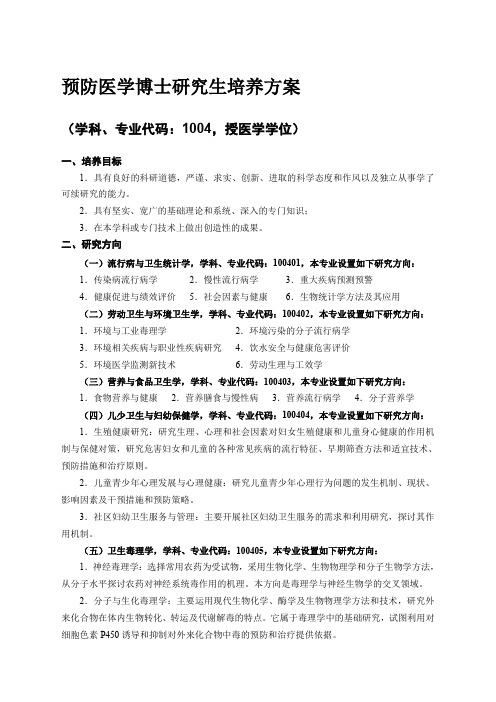
预防医学博士研究生培养方案(学科、专业代码:1004,授医学学位)一、培养目标1.具有良好的科研道德,严谨、求实、创新、进取的科学态度和作风以及独立从事学了可续研究的能力。
2.具有坚实、宽广的基础理论和系统、深入的专门知识;3.在本学科或专门技术上做出创造性的成果。
二、研究方向(一)流行病与卫生统计学,学科、专业代码:100401,本专业设置如下研究方向:1.传染病流行病学2.慢性流行病学3.重大疾病预测预警4.健康促进与绩效评价5.社会因素与健康6.生物统计学方法及其应用(二)劳动卫生与环境卫生学,学科、专业代码:100402,本专业设置如下研究方向:1.环境与工业毒理学2.环境污染的分子流行病学3.环境相关疾病与职业性疾病研究4.饮水安全与健康危害评价5.环境医学监测新技术6.劳动生理与工效学(三)营养与食品卫生学,学科、专业代码:100403,本专业设置如下研究方向:1.食物营养与健康2.营养膳食与慢性病3.营养流行病学4.分子营养学(四)儿少卫生与妇幼保健学,学科、专业代码:100404,本专业设置如下研究方向:1.生殖健康研究:研究生理、心理和社会因素对妇女生殖健康和儿童身心健康的作用机制与保健对策,研究危害妇女和儿童的各种常见疾病的流行特征、早期筛查方法和适宜技术、预防措施和治疗原则。
2.儿童青少年心理发展与心理健康:研究儿童青少年心理行为问题的发生机制、现状、影响因素及干预措施和预防策略。
3.社区妇幼卫生服务与管理:主要开展社区妇幼卫生服务的需求和利用研究,探讨其作用机制。
(五)卫生毒理学,学科、专业代码:100405,本专业设置如下研究方向:1.神经毒理学:选择常用农药为受试物,采用生物化学、生物物理学和分子生物学方法,从分子水平探讨农药对神经系统毒作用的机理。
本方向是毒理学与神经生物学的交叉领域。
2.分子与生化毒理学:主要运用现代生物化学、酶学及生物物理学方法和技术,研究外来化合物在体内生物转化、转运及代谢解毒的特点。
公共卫生硕士专业学位(流行病与卫生统计)培养方案
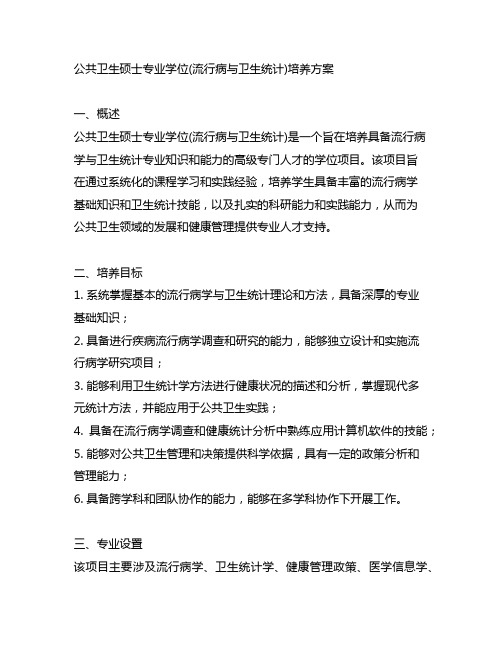
公共卫生硕士专业学位(流行病与卫生统计)培养方案一、概述公共卫生硕士专业学位(流行病与卫生统计)是一个旨在培养具备流行病学与卫生统计专业知识和能力的高级专门人才的学位项目。
该项目旨在通过系统化的课程学习和实践经验,培养学生具备丰富的流行病学基础知识和卫生统计技能,以及扎实的科研能力和实践能力,从而为公共卫生领域的发展和健康管理提供专业人才支持。
二、培养目标1. 系统掌握基本的流行病学与卫生统计理论和方法,具备深厚的专业基础知识;2. 具备进行疾病流行病学调查和研究的能力,能够独立设计和实施流行病学研究项目;3. 能够利用卫生统计学方法进行健康状况的描述和分析,掌握现代多元统计方法,并能应用于公共卫生实践;4. 具备在流行病学调查和健康统计分析中熟练应用计算机软件的技能;5. 能够对公共卫生管理和决策提供科学依据,具有一定的政策分析和管理能力;6. 具备跨学科和团队协作的能力,能够在多学科协作下开展工作。
三、专业设置该项目主要涉及流行病学、卫生统计学、健康管理政策、医学信息学、生物统计学和流行病动力学等相关专业知识。
具体的课程设置包括但不限于基本卫生统计学、流行病学原理、生物统计学、环境卫生统计学、流行病调查与分析方法、统计软件应用、卫生经济学等。
四、教学方法1. 系统课程学习学生在校期间将学习一系列的专业课程,包括理论课、实验课和实习课。
通过系统课程学习,学生将全面掌握流行病学原理和卫生统计学方法,建立健全的专业知识体系。
2. 实践教学学生将通过实习、实习等形式的实践教学,掌握流行病学调查、数据分析、健康统计与管理等实际操作技能。
实践教学内容将与公共卫生领域实际工作密切相关,为学生提供真实的实践场景。
3. 科研训练在导师的指导下,学生将参与科研项目、论文撰写等内容,培养科研能力和科研素养。
五、学位论文要求1. 学位论文的选题应当符合公共卫生工作的需要,具有理论意义和实际应用价值;2. 学位论文应有较强的创新性和科研性,研究方法应符合学术规范;3. 学位论文的撰写应符合学术规范和论文写作规则,语言通顺、表述准确、逻辑清晰。
苏州大学研究生学号编制规范

(2008年6月)
研究生学号由研究生部负责编制。苏州大学研究生学号统一采用14位设计,其中1~4位为入学年度(如2007),5~6位为学生类别代码(见表1“学生类别代码”),7~8为培养单位代码(见表2“培养单位代码”),9~11为专业编号(见表3“研究生专业编号”),12~14位为本院系流水序号。
学科教学.体育
06
体育学院
827
540101
体育教学
06
体育学院
824
540102
运动训练
07
数学科学学院
020
040102
课程与教学论
07
数学科学学院
046
070101
基础数学
07
数学科学学院
047
070102
计算数学
07
数学科学学院
048
070103
概率论与数理统计
07
数学科学学院
049
070104
21
医学部基础医学与生物科学学院
092
100102
免疫学
21
医学部基础医学与生物科学学院
093
100103
病原生物学
21
医学部基础医学与生物科学学院
094
100104
病理学与病理生理学
21
医学部基础医学与生物科学学院
095
100105
法医学
21
医学部基础医学与生物科学学院
096
100706
药理学
21
078
020101
政治经济学
10
商学院(财经学院)
079
020105
基础医学(学科代码1001)
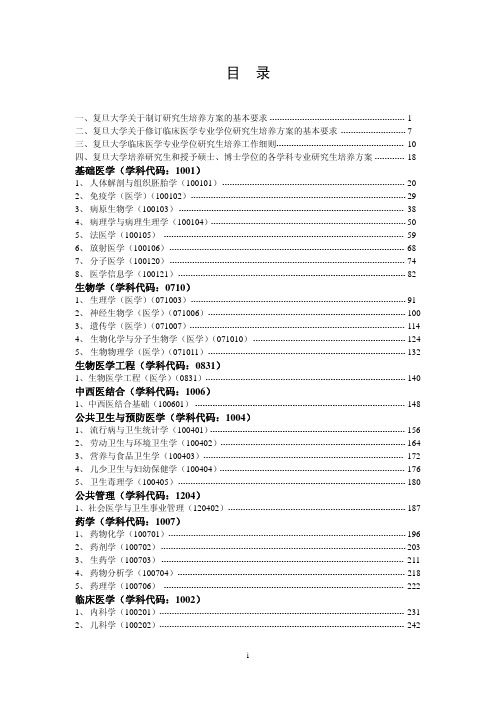
目 录一、复旦大学关于制订研究生培养方案的基本要求 1二、复旦大学关于修订临床医学专业学位研究生培养方案的基本要求7三、复旦大学临床医学专业学位研究生培养工作细则10四、复旦大学培养研究生和授予硕士、博士学位的各学科专业研究生培养方案 18 基础医学(学科代码:1001)1、人体解剖与组织胚胎学(100101)202、免疫学(医学)(100102)293、病原生物学(100103)384、病理学与病理生理学(100104)505、法医学(100105)596、放射医学(100106)687、分子医学(100120)748、医学信息学(100121)82生物学(学科代码:0710)1、生理学(医学)(071003)912、神经生物学(医学)(071006)1003、遗传学(医学)(071007)1144、生物化学与分子生物学(医学)(071010)1245、生物物理学(医学)(071011)132 生物医学工程(学科代码:0831)1、生物医学工程(医学)(0831)140 中西医结合(学科代码:1006)1、中西医结合基础(100601)148 公共卫生与预防医学(学科代码:1004)1、流行病与卫生统计学(100401)1562、劳动卫生与环境卫生学(100402)1643、营养与食品卫生学(100403)1724、儿少卫生与妇幼保健学(100404)1765、卫生毒理学(100405)180 公共管理(学科代码:1204)1、社会医学与卫生事业管理(120402)187 药学(学科代码:1007)1、药物化学(100701)1962、药剂学(100702)2033、生药学(100703)2114、药物分析学(100704)2185、药理学(100706)222 临床医学(学科代码:1002)1、内科学(100201)2312、儿科学(100202)2423、老年医学(100203)2534、神经病学(100204)2575、精神病学与精神卫生学(100205)2646、皮肤病与性病学(100206)2707、影像医学与核医学(100207)2768、临床检验诊断学(100208)2849、护理学(100209)29010、外科学(100210)29711、妇产科学(100211)30812、眼科学(100212)31613、耳鼻咽喉科学(100213)32214、肿瘤学(100214)32815、康复医学与理疗学(100215)33516、运动医学(100216)34217、麻醉学(100217)34818、急诊医学(100218)35419、显微医学(100220)35720、全科医学(100221)36421、循证医学(100222)368 口腔医学(学科代码:1003)1、口腔临床医学(100302)372 中西医结合(学科代码:1006)1、中西医结合临床(100602)376医学专业学位临床医学(学科代码:1002)1、内科学(100201)3862、儿科学(儿内)(100202)403儿科学(儿外)4123、老年医学(100203)4194、神经病学(100204)4245、精神病学与精神卫生学(100205)4296、皮肤病与性病学(100206)4357、影像医学与核医学(100207)4398、外科学(100210)4489、妇产科学(100211)46210、眼科学(100212)47111、耳鼻咽喉科学(100213)47612、肿瘤学(100214)48313、麻醉学(100217)49214、急诊医学(100218)498口腔医学(学科代码:1003)1、口腔临床医学(100302)503 中西医结合(学科代码:1006)1、中西药结合临床(100602)508五、复旦大学培养研究生学科、专业目录(科学学位)517六、复旦大学培养研究生学科、专业目录(专业学位)524七、编后525。
教育部学位授予和人才培养学科目录

教育部学位授予和人才培养学科目录0101 哲学010101 马克思主义哲学010102 中国哲学010103 外国哲学010104 逻辑学010105 伦理学010106 美学010107 宗教学010108 科学技术哲学02 经济学0201 理论经济学020101 政治经济学020102 经济思想史020103 经济史020104 西方经济学020105 世界经济020106 人口、资源与环境经济学0202 应用经济学020201 国民经济学020202 区域经济学020203 财政学(含:税收学)020204 金融学(含:保险学)020205 产业经济学020206 国际贸易学020207 劳动经济学020208 统计学020209 数量经济学020210 国防经济03 法学0301 法学030101 法学理论030102 法律史030103 宪法学与行政法学030104 刑法学030105 民商法学(含:劳动法学、社会保障法学) 030106 诉讼法学030107 经济法学030108 环境与资源保护法学030109 国际法学(含:国际公法、国际私法、国际经济法) 030110 军事法学0302 政治学030201 政治学理论030202 中外政治制度030203 科学社会主义与国际共产主义运动030204 中共党史(含:党的学说与党的建设)030206 国际政治030207 国际关系030208 外交学0303 社会学030301 社会学030302 人口学030303 人类学030304 民俗学(含:中国民间文学)0304 民族学030401 民族学030402 马克思主义民族理论与政策030403 中国少数民族经济030404 中国少数民族史030405 中国少数民族艺术0305 马克思主义理论(2005年增设)030501 马克思主义基本原理030502 马克思主义发展史030503 马克思主义中国化研究030504 国外马克思主义研究030505 思想政治教育030506 中国近代史基本问题研究(2008年增设)04 教育学0401 教育学040101 教育学原理040102 课程与教学论040103 教育史040104 比较教育学040105 学前教育学040106 高等教育学040107 成人教育学040108 职业技术教育学040109 特殊教育学040110 教育技术学(可授教育学、理学学位)0402 心理学(可授教育学、理学学位)040201 基础心理学040202 发展与教育心理学040203 应用心理学0403 体育学040301 体育人文社会学040302 运动人体科学(可授教育学、理学、医学学位) 040303 体育教育训练学040304 民族传统体育学05 文学0501 中国语言文学050101 文艺学050102 语言学及应用语言学050103 汉语言文字学050104 中国古典文献学050105 中国古代文学050106 中国现当代文学050107 中国少数民族语言文学(分语族)050108 比较文学与世界文学0502 外国语言文学050201 英语语言文学050202 俄语语言文学050203 法语语言文学050204 德语语言文学050205 日语语言文学050206 印度语言文学050207 西班牙语语言文学050208 阿拉伯语语言文学050209 欧洲语言文学050210 亚非语言文学050211 外国语言学及应用语言学0503 新闻传播学050301 新闻学050302 传播学0504 艺术学050401 艺术学050402 音乐学050403 美术学050404 设计艺术学050405 戏剧戏曲学050406 电影学050407 广播电视艺术学050408 舞蹈学06 历史学0601 历史学060101 史学理论及史学史060102 考古学及博物馆学060103 历史地理学060104 历史文献学(含:敦煌学、古文字学) 060105 专门史060106 中国古代史060107 中国近现代史060108 世界史07 理学0701 数学070101 基础数学070102 计算数学070103 概率论与数理统计070104 应用数学070105 运筹学与控制论0702 物理学070201 理论物理070202 粒子物理与原子核物理070203 原子与分子物理070204 等离子体物理070205 凝聚态物理070206 声学070207 光学070208 无线电物理0703 化学070301 无机化学070302 分析化学070303 有机化学070304 物理化学(含:化学物理) 070305 高分子化学与物理0704 天文学070401 天体物理070402 天体测量与天体力学0705 地理学070501 自然地理学070502 人文地理学070503 地图学与地理信息系统0706 大气科学070601 气象学070602 大气物理学与大气环境0707 海洋科学070701 物理海洋学070702 海洋化学070703 海洋生物学070704 海洋地质0708 地球物理学070801 固体地球物理学070802 空间物理学0709 地质学070901 矿物学、岩石学、矿床学070902 地球化学070903 古生物学与地层学(含:古人类学) 070904 构造地质学070905 第四纪地质学0710 生物学071001 植物学071002 动物学071003 生理学071004 水生生物学071005 微生物学071006 神经生物学071007 遗传学071008 发育生物学071009 细胞生物学071010 生物化学与分子生物学071011 生物物理学071012 生态学0711 系统科学071101 系统理论071102 系统分析与集成0712 科学技术史(分学科,可授理学、工学、农学、医学学位) 注:本一级学科不分设二级学科(学科、专业)08 工学0801 力学(可授工学、理学学位)080101 一般力学与力学基础080102 固体力学080103 流体力学080104 工程力学0802 机械工程080201 机械制造及其自动化080202 机械电子工程080203 机械设计及理论080204 车辆工程0803 光学工程注: 本一级学科不分设二级学科(学科、专业)0804 仪器科学与技术080401 精密仪器及机械080402 测试计量技术及仪器0805 材料科学与工程080501 材料物理与化学080502 材料学080503 材料加工工程0806 冶金工程80601 冶金物理化学080602 钢铁冶金080603 有色金属冶金0807 动力工程及工程热物理080701 工程热物理080702 热能工程080703 动力机械及工程080704 流体机械及工程080705 制冷及低温工程080706 化工过程机械0808 电气工程080801 电机与电器080802 电力系统及其自动化080803 高电压与绝缘技术080804 电力电子与电力传动080805 电工理论与新技术0809 电子科学与技术(可授工学、理学学位)080901 物理电子学080902 电路与系统080903 微电子学与固体电子学080904 电磁场与微波技术0810 信息与通信工程081001 通信与信息系统081002 信号与信息处理0811 控制科学与工程081101 控制理论与控制工程081102 检测技术与自动化装置081103 系统工程081104 模式识别与智能系统081105 导航、制导与控制0812 计算机科学与技术(可授工学、理学学位)081201 计算机系统结构081202 计算机软件与理论081203 计算机应用技术0813 建筑学081301 建筑历史与理论081302 建筑设计及其理论081303 城市规划与设计(含:风景园林规划与设计)081304 建筑技术科学0814 土木工程081401 岩土工程081402 结构工程081403 市政工程081404 供热、供燃气、通风及空调工程081405 防灾减灾工程及防护工程081406 桥梁与隧道工程0815 水利工程081501 水文学及水资源081502 水力学及河流动力学081503 水工结构工程081504 水利水电工程081505 港口、海岸及近海工程0816 测绘科学与技术081601 大地测量学与测量工程081602 摄影测量与遥感081603 地图制图学与地理信息工程0817 化学工程与技术081701 化学工程081702 化学工艺081703 生物化工081704 应用化学081705 工业催化0818 地质资源与地质工程081801 矿产普查与勘探081802 地球探测与信息技术081803 地质工程0819 矿业工程081901 采矿工程081902 矿物加工工程081903 安全技术及工程0820 石油与天然气工程082001 油气井工程082002 油气田开发工程082003 油气储运工程0821 纺织科学与工程082101 纺织工程082102 纺织材料与纺织品设计082103 纺织化学与染整工程082104 服装设计与工程0822 轻工技术与工程082201 制浆造纸工程082202 制糖工程082203 发酵工程082204 皮革化学与工程0823 交通运输工程082301 道路与铁道工程082302 交通信息工程及控制082303 交通运输规划与管理082304 载运工具运用工程0824 船舶与海洋工程082401 船舶与海洋结构物设计制造082402 轮机工程082403 水声工程0825 航空宇航科学与技术082501 飞行器设计082502 航空宇航推进理论与工程082503 航空宇航制造工程082504 人机与环境工程0826 兵器科学与技术082601 武器系统与运用工程082602 兵器发射理论与技术082603 火炮、自动武器与弹药工程082604 军事化学与烟火技术0827 核科学与技术082701 核能科学与工程082702 核燃料循环与材料082703 核技术及应用082704 辐射防护及环境保护0828 农业工程082801 农业机械化工程082802 农业水土工程082803 农业生物环境与能源工程082804 农业电气化与自动化0829 林业工程082901 森林工程082902 木材科学与技术082903 林产化学加工工程0830 环境科学与工程(可授工学、理学、农学学位)083001 环境科学083002 环境工程0831 生物医学工程(可授工学、理学、医学学位)注:本一级学科不分设二级学科(学科、专业)0832 食品科学与工程(可授工学、农学学位)083201 食品科学083202 粮食、油脂及植物蛋白工程083203 农产品加工及贮藏工程083204 水产品加工及贮藏工程09 农学0901 作物学090101 作物栽培学与耕作学090102 作物遗传育种0902 园艺学090201 果树学090202 蔬菜学090203 茶学0903 农业资源利用090301 土壤学090302 植物营养学0904 植物保护090401 植物病理学090402 农业昆虫与害虫防治090403 农药学(可授农学、理学学位)0905 畜牧学090501 动物遗传育种与繁殖090502 动物营养与饲料科学090503 草业科学090504 特种经济动物饲养(含:蚕、蜂等)0906 兽医学090601 基础兽医学090602 预防兽医学090603 临床兽医学0907 林学090701 林木遗传育种090702 森林培育090703 森林保护学090704 森林经理学090705 野生动植物保护与利用090706 园林植物与观赏园艺090707 水土保持与荒漠化防治0908 水产090801 水产养殖090802 捕捞学090803 渔业资源10 医学1001 基础医学(可授医学、理学学位)100101 人体解剖与组织胚胎学100102 免疫学100103 病原生物学100104 病理学与病理生理学100105 法医学100106 放射医学100107 航空、航天与航海医学1002 临床医学100201 内科学(含:心血管病、血液病、呼吸系病、消化系病、内分泌与代谢病、肾病、风湿病、传染病)100202 儿科学100203 老年医学100204 神经病学100205 精神病与精神卫生学100206 皮肤病与性病学100207 影像医学与核医学100208 临床检验诊断学100209 护理学100210 外科学(含:普外、骨外、泌尿外、胸心外、神外、整形、烧伤、野战外)100211 妇产科学100212 眼科学100213 耳鼻咽喉科学100214 肿瘤学100215 康复医学与理疗学100216 运动医学100217 麻醉学100218 急诊医学1003 口腔医学100301 口腔基础医学100302 口腔临床医学1004 公共卫生与预防医学(可授医学、理学学位)100401 流行病与卫生统计学100402 劳动卫生与环境卫生学100403 营养与食品卫生学100404 儿少卫生与妇幼保健学100405 卫生毒理学100406 军事预防医学1005 中医学100501 中医基础理论100502 中医临床基础100503 中医医史文献100504 方剂学100505 中医诊断学100506 中医内科学100507 中医外科学100508 中医骨伤科学100509 中医妇科学100510 中医儿科学100511 中医五官科学100512 针灸推拿学100513 民族医学(含:藏医学、蒙医学等) 注:本二级学科1998年增设1006 中西医结合100601 中西医结合基础100602 中西医结合临床1007 药学(可授医学、理学学位)100701 药物化学100702 药剂学100703 生药学100704 药物分析学100705 微生物与生化药学100706 药理学1008 中药学注:本一级学科不分设二级学科(学科、专业) 11 军事学1101 军事思想及军事历史110101 军事思想110102 军事历史1102 战略学110201 军事战略学110202 战争动员学1103 战役学110301 联合战役学110302 军种战役学(含:第二炮兵战役学) 1104 战术学110401 合同战术学110402 兵种战术学1105 军队指挥学110501 作战指挥学110502 军事运筹学110503 军事通信学110504 军事情报学110505 密码学110506 军事教育训练学(含:军事体育学) 1106 军制学110601 军事组织编制学110602 军队管理学1107 军队政治工作学注:本一级学科不分设二级学科(学科、专业) 1108 军事后勤学与军事装备学110801 军事后勤学110802 后方专业勤务110803 军事装备学12 管理学1201 管理科学与工程(可授管理学、工学学位)注:本一级学科不分设二级学科(学科、专业)1202 工商管理120201 会计学120202 企业管理(含:财务管理、市场营销、人力资源管理)120203 旅游管理120204 技术经济及管理1203 农林经济管理120301 农业经济管理120302 林业经济管理1204 公共管理120401 行政管理120402 社会医学与卫生事业管理(可授管理学、医学学位) 120403 教育经济与管理(可授管理学、教育学学位)120404 社会保障120405 土地资源管理1205 图书馆、情报与档案管理120501 图书馆学120502 情报学120503 档案学。
公共卫生与预防医学硕士研究生培养方案

“公共卫生与预防医学”硕士研究生培养方案学科代码:1004一、培养目标培养系统掌握公共卫生与预防医学专业的基础知识和基本技能,了解公共卫生与预防医学的前沿理论知识,系统了解科学研究工作过程,并具有一定的开展科学研究的基本能力。
掌握一门外语,具有参与国内和国际学术交流、表达学术思想及展示学术成果的能力。
具备较好的学术潜力、创新意识及学术洞察力,具备有效获取知识、科学研究、实践技术、学术交流、探索和解决实际问题的能力。
遵循学术研究伦理,具有高度的社会责任感,有志于为社会发展和人类健康事业做出贡献的公共卫生与预防医学专业高层次专门人才。
二、研究方向1.“卫生毒理学”:主要研究相关化学物的毒性机理,并应用细胞传感技术、纳米传感技术、基因重组技术、转基因技术、干细胞传感技术、生物发光技术、化学发光技术等,开发新的安全评价方法。
2.“流行病与卫生统计学”:主要研究常见慢性病的遗传因素、环境因素及遗传与环境的相互作用;开展社区常见慢性病防治;对常见慢性病进行流行病学调查分析,探索治疗慢性病的新临床路径。
3.“劳动卫生与环境卫生学”:对职业性有害因素评价、职业健康监护、职业紧张、环境有害因素与健康进行人群调查,及早发现有关职业有害因素,为保护人民健康,促进生产力发展服务;开展环境污染新监测方法研究,如利用生物传感技术,受体结合试验技术等,对环境污染进行生物学监测。
4.“营养与食品卫生学”:主要研究范围包括食品营养与健康、食品卫生与安全、烹饪营养与卫生、食品检验与品质控制。
用现代科学技术与实践经验,指导国民饮食生活实践,阐明营养素生理功能,发现活性成分,不断提高烹调食品及其制品的安全卫生水平,从而达到控制食源性疾病发生的目的。
三、学习年限全日制学术学位硕士研究生学制一般为3年。
四、培养方式导师责任制:实行导师负责和学科集体培养相结合的培养方式,指导教师是研究生培养的第一责任人。
指导教师应教书育人,关心研究生的成长,引导他们走德、智、体全面发展的道路;研究生要尊敬师长,虚心学习,积极进取,做到教学相长。
对环境工程培养方案的意见

对环境工程培养方案的意见一、培养目标环境工程专业的培养目标应当包括以下几个方面:一是培养具有基础扎实、专业知识全面的环境工程专业人才;二是培养具有工程实践能力、创新能力和团队协作精神的应用型人才;三是培养具有社会责任感和环保意识的高素质人才。
基础课程设置环境工程专业的基础课程设置应当包括数学、物理、化学等自然科学基础课程,同时还应包括环境科学基础、环境工程原理、环境化学、环境生物学等专业基础课程。
此外,还应开设专门的研究方法和技能培训课程,培养学生的实验和研究能力。
专业课程设置环境工程专业的专业课程设置应当包括环境监测与评价、环境保护工程、水污染控制工程、大气污染控制工程、固体废物处理与处置、环境影响评价等内容。
在课程设置上应注重理论与实践相结合,培养学生的实际操作能力和解决问题的能力。
实践教学环境工程专业的实践教学应当贯穿学生的整个学习过程。
从校外实习、实训基地建设、毕业设计等方面提高学生的实践操作能力和问题解决能力。
此外,还应鼓励学生积极参与社会实践和科技创新活动,培养学生的创新能力和团队合作精神。
师资队伍环境工程专业的师资队伍应当具有较高的学术水平和丰富的实践经验。
应该优化师资结构,引进优秀的教师和科研人员,同时也要加强对青年教师的培养和引进。
此外,还应该鼓励教师参与科研项目和实际工程项目,不断提升自身的科研和实践能力。
综上所述,环境工程专业的培养方案应当注重培养学生的基础知识和实践技能,注重理论与实践相结合,培养学生的创新能力和团队协作精神,注重教师队伍的建设和科研实践。
只有这样,才能培养出更多高素质的环境工程专业人才,为社会和经济的可持续发展做出更大的贡献。
四川大学2018年公共卫生学院硕士推免生专业目录_川大考研网
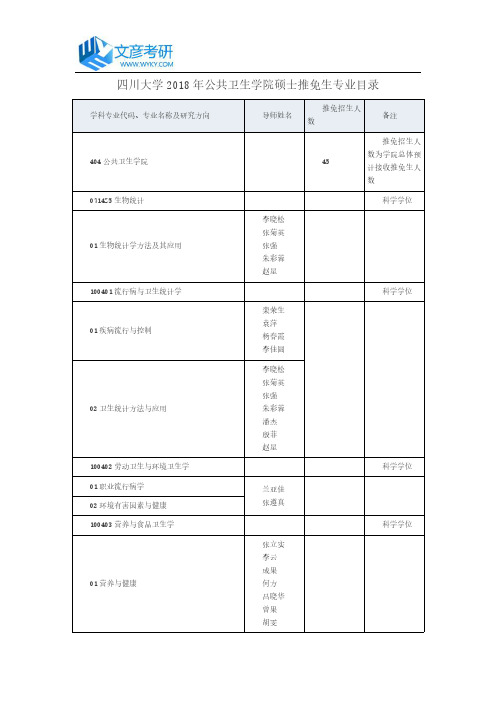
学科专业代码、专业名称及研究方向 404 公共卫生学院 0714Z5 生物统计 01 生物统计学方法及其应用 100401 流行病与卫生统计学 01 疾病流行与控制
02 卫生统计方法与应用
100402 劳动卫生与环境卫生学 01 职业流行病学 02 环境有害因素与健康 100403 营养与食品卫生学
02 微生物、公众健康与检验
1004Z3 老年保健与姑息医学
李鸣 张立实 李云 成果 何方 吕晓华 曾果 李鸣
张建新
张立实 徐培渝 黄毅娜
马骁 周欢 刘巧兰 李宁秀 杨洋 马骁 周欢 刘巧兰 李宁秀 刘丹萍
孙成均 李永新 裴晓方 许欣 王国庆 汪川 陈昭斌* 张慧东
科学学位 科学学位 科学学位
科学学位
01 营养与健康
导师姓名
推免招生人 数
备数
科学学位
李晓松 张菊英 张强 朱彩蓉 赵星
科学学位
栾荣生 袁萍 杨春霞 李佳圆
李晓松 张菊英 张强 朱彩蓉 潘杰 殷菲 赵星
科学学位
兰亚佳 张遵真
张立实 李云 成果 何方 吕晓华 曾果 胡雯
科学学位
02 食品安全
03 食品营养与功能评价
100404 儿少卫生与妇幼保健学 01 儿少卫生与妇幼保健 02 艾滋病的防控研究 100405 卫生毒理学 01 管理毒理学 02 食品毒理学 1004Z1 健康与社会行为学
01 健康相关行为研究
02 健康社会决定因素
1004Z2 卫生检验与检疫 01 卫生理化检验方法及其应用研究
01 社会医学
02 医疗保健制度 03 基层与农村卫生政策
熊海 曾果
刘毅 陈丹镝 潘杰 兰亚佳 张晓晴 赵立强
公共卫生与预防医学研究生培养方案 版
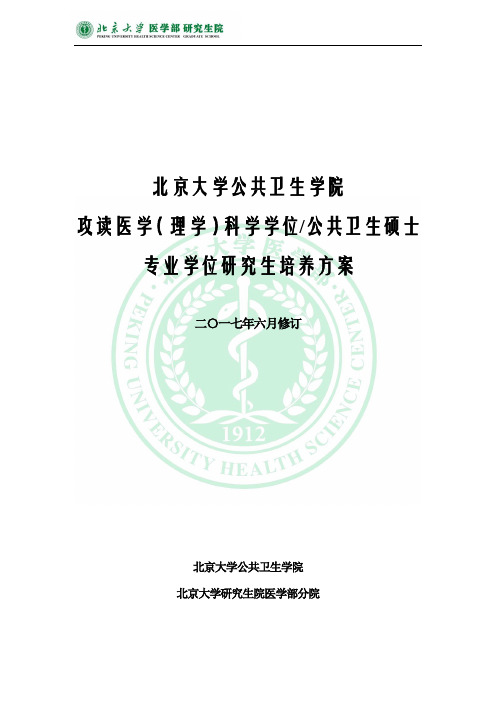
北京大学公共卫生学院攻读医学(理学)科学学位/公共卫生硕士专业学位研究生培养方案二〇一七年六月修订北京大学公共卫生学院北京大学研究生院医学部分院目录公共卫生学院攻读医学科学(理学)硕士学位研究生培养方案攻读医学科学(理学)硕士学位研究生培养方案总则 (1)流行病与卫生统计学 (6)劳动卫生与环境卫生学 (8)营养与食品卫生学 (10)儿少卫生与妇幼保健学 (12)卫生毒理学 (14)社会医学与卫生事业管理 (16)公共卫生学院攻读医学科学(理学)博士学位研究生培养方案攻读医学科学(理学)博士学位研究生培养方案总则 (18)流行病与卫生统计学 (23)劳动卫生与环境卫生学 (25)营养与食品卫生学 (27)儿少卫生与妇幼保健学 (28)卫生毒理学 (30)社会医学与卫生事业管理 (32)公共卫生学院直接攻读医学科学(理学)博士学位研究生培养方案直接攻读医学科学(理学)博士学位研究生培养方案总则 (34)流行病与卫生统计学 (40)劳动卫生与环境卫生学 (42)营养与食品卫生学 (45)儿少卫生与妇幼保健学 (47)卫生毒理学 (49)社会医学与卫生事业管理 (52)公共卫生学院攻读公共卫生硕士专业学位研究生(全日制)培养方案 (55)公共卫生学院攻读公共卫生硕士专业学位研究生(非全日制)培养方案 (59)公共卫生学院攻读公共卫生博士专业学位研究生培养方案 (63)预防医学长学制研究生阶段培养方案预防医学长学制研究生阶段培养方案总则 (68)流行病与卫生统计学 (73)劳动卫生与环境卫生学 (74)营养与食品卫生学 (75)儿少卫生与妇幼保健学 (77)卫生毒理学 (78)社会医学与卫生事业管理 (80)北京大学公共卫生学院攻读医学科学(理学)硕士学位研究生培养方案总则第一条培养目标培养硕士学位研究生(以下简称硕士生)必须坚持德、智、体、能全面发展,能适应我国公共卫生事业发展需要的高素质、高层次的专门人才,具体要求:一、严格遵守国家法律、法规,具有严谨求实的学风和良好的学术道德与行为规范。
《授予博士、硕士学位和培养研究生的学科、专业目录》(

《授予博士、硕士学位和培养研究生的学科、专业目录》(1997年颁布)一、《授予博士、硕士学位和培养研究生的学科、专业目录》(1997年颁布),是国务院学位委员会学科评议组审核授予学位的学科、专业范围划分的依据。
同时,学位授予单位按本目录中各学科、专业所归属的学科门类,授予相应的学位。
培养研究生的高等学校和科研机构以及各有关主管部门,可以参照本目录制订培养研究生的规划,进行招生和培养工作。
二、本目录是在1990年10月国务院学位委员会和国家教育委员会联合下发的《授予博士、硕士学位和培养研究生的学科、专业目录》(以下简称原目录)的基础上经过多次征求意见、反复论证修订的。
修订的主要原则是∶科学、规范、拓宽;修订的目标是:逐步规范和理顺一级学科,拓宽和调整二级学科。
本目录与原目录相比,有如下变化∶增加了管理学学科门类,授予学位的学科门类增加到12个;一级学科由原来的72个增加到88个,二级学科(学科、专业)由原来的654种调整为382种。
各学科门类的学科、专业设置情况是∶哲学,1个一级学科,8种学科、专业;经济学,2个一级学科,16种学科、专业;法学,4个一级学科,27种学科、专业;教育学,3个一级学科,17种学科、专业;文学,4个一级学科,29种学科、专业;历史学,1个一级学科,8种学科、专业;理学,12个一级学科,50种学科、专业;工学,32个一级学科,113种学科、专业;农学,8个一级学科,27种学科、专业;医学,8个一级学科,54种学科、专业;军事学,8个一级学科,19种学科、专业;管理学,5个一级学科,14种学科、专业。
三、本目录中有16个二级学科带"(含∶)",括号中的内容是对二级学科所包含内容的强调或补充,其学位授权和研究生培养除医学门类中有关学科按括号中的内容进行外,其它学科均按二级学科进行。
"科学技术史(分学科)"、"中国少数民族语言文学(分语族)",其学位授权点的审核、授权和研究生培养按括号中限定的学科范围进行。
授予博士、硕士学位和培养研究生的学科、专业目录(2008更
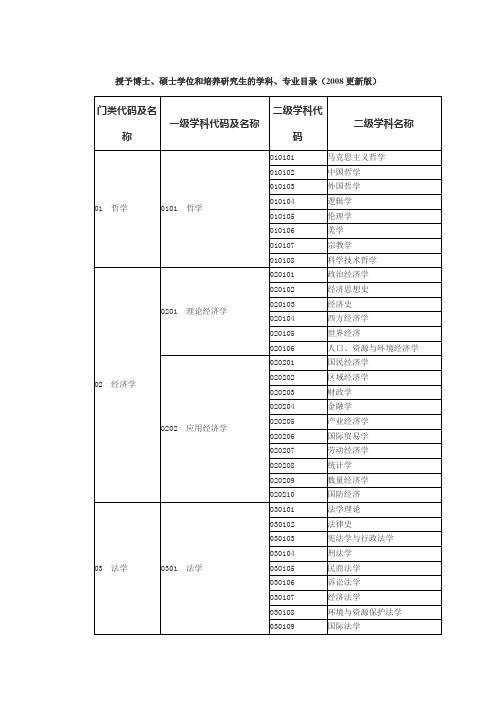
080401
精密仪器及机械
080402
测试计量技术及仪器
0805材料科学与工程
080501
材料物理与化学
080502
材料学
080503
材料加工工程
0806冶金工程
080601
冶金物理化学
080602
钢铁冶金
080603
有色金属冶金
0807动力工程及工程热物理
080701
工程热物理
0819矿业工程
081901
采矿工程
081902
矿物加工工程
081903
安全技术及工程
0820石油与天然气工程
082001
油气井工程
082002
油气田开发工程
082003
油气储运工程
0821纺织科学与工程
082101
纺织工程
082102
纺织材料与纺织品设计
082103
纺织化学与染整工程
082104
服装设计与工程
中国古代文学
050106
中国现当代文学
050107
中国少数民族语言文学
050108
比较文学与世界文学
0502外国语言文学
050201
英语语言文学
050202
俄语语言文学
050203
法语语言文学
050204
德语语言文学
050205
日语语言文学
050206
印度语言文学
050207
西班牙语语言文学
050208
大地测量学与测量工程
081602
摄影测量与遥感
081603
地图制图学与地理信息工程
- 1、下载文档前请自行甄别文档内容的完整性,平台不提供额外的编辑、内容补充、找答案等附加服务。
- 2、"仅部分预览"的文档,不可在线预览部分如存在完整性等问题,可反馈申请退款(可完整预览的文档不适用该条件!)。
- 3、如文档侵犯您的权益,请联系客服反馈,我们会尽快为您处理(人工客服工作时间:9:00-18:30)。
劳动卫生与环境卫生学硕士科学学位培养方案一、培养目标见总则。
二、学科简介劳动卫生与环境卫生学是公共卫生与预防医学的一个重要分支学科。
它是研究劳动条件、自然环境和生活环境与人群健康的关系,揭示环境因素和职业性有害因素对人群健康影响的发生、发展规律;并研究利用有利环境因素,控制不利环境因素和职业性有害因素的对策,预防职业病和与环境有关的疾病,以保障人群健康的一门科学。
Occupational health and environmental hygiene is an important branch of public health and preventive medicine. It is a study of working conditions, the natural environment and the relationship between living environment and human health, revealed the environmental factors and effects of occupational harmful factors on the health of the population, development of law and research use of advantageous environmental factors and control adverse environmental factors and countermeasures of occupational hazardous factors, prevention of occupational diseases and the environment-related diseases, to protect the health of a science.三、研究方向1.化学性毒物与健康;2.空气污染与健康;3.公共卫生安全与职业流行病学。
四、学习年限及时间安排见总则。
五、学习过程学分要求研究生课程学习实行学分制,科学学位硕士生课程学习学分要求为18.0学分。
1.公共必修课共7.5学分外语(英语) 90学时 4.0学分自然辩证法 54学时 2.0学分科学社会主义 36学时 1.5学分2.必选课至少4门至少6.5学分医学科研中的统计学方法 65学时 3.0学分医学科研方法学(科学型)36学时 2.0学分生命科学理论课程一门,至少1.0学分。
由导师与研究生根据研究方向,从以下几门课程中选修:细胞生物学研究进展 18学时 1.0学分分子生物学研究进展 18学时 1.0学分免疫学研究进展 18学时 1.0学分实验技术课程或专业基础课程一门,至少1.0学分。
由导师与研究生根据研究方向,从以下几门课程中选修:分子生物学实验技术 42学时 2.0学分实用动物细胞培养技术 54学时 2.0学分实验动物学实验——动物实验基本技术 16学时 1.0学分现代环境卫生学 18学时 1.0学分高级劳动卫生学 18学时 1.0学分高级毒理学 28学时 1.5学分3.选修课 4.0学分(从选课表中选择)六、教学工作要求见总则。
七、科研训练与学位论文工作见总则。
八、学位评定与授予见总则。
九、培养方式与要求见总则。
十、主要参考书刊:1.蔡宏道.现代环境卫生学.北京:人民卫生出版社.1995.2.王簃兰.现代劳动卫生学.北京:人民卫生出版社.1994.3.金泰廙.职业卫生与职业医学.北京:人民卫生出版社.2007.4.杨克敌.环境卫生学.北京:人民卫生出版社.2007.5.何凤生.中华职业医学.北京:人民卫生出版社.1999.6.俞文钊.职业心理学.北京:东北财经大学出版社.2000.预防医学是以“环境-人群-健康”为模式,以人群为研究对象,以预防为主要思想指导,运用现代医学知识和方法研究环境对健康影响的规律,制定预防人类疾病发生的措施,实现促进健康,预防伤残和夭折为目的的一门科学。
预防医学的特点包括:工作对象包括个体和群体,工作重点是健康和无症状患者,对策与措施更具积极预防作用,更具人群健康效益,研究方法上更注重微观和宏观相结合,研究重点是环境与人群健康之间的关系。
预防医学与临床医学不同之处在于她是以人群为对象,而不是仅限于以个体为对象。
医学发展的趋势之一,是从个体医学发展到群体医学,今天许多医学问题的真正彻底解决,不可能离开群体和群体医学方法。
预防医学的任务要求它必须高瞻远瞩,面向医学的未来,从战略的高度考虑人类的疾病和健康问题。
该学科应用现代医学及其他科学技术手段研究人体健康与环境因素之间的关系,制定疾病防治策略与措施,以达到控制疾病,保障人民健康,延长人类寿命之目的。
随着医学模式的发展,该专业日益显示出其在医学科学中的重要性。
该专业培养从事预防医学实验工作与科研工作,具有一定卫生管理知识和外语水平的卫生医师。
学生在掌握一般临床医学理论知识与技能的基础上,能系统地掌握本专业的基础理论、基本知识和基本技能,能运用所学的知识、技能从事实际工作和科学研究工作。
业务培养目标:本专业培养具备预防医学基本理论知识和卫生检测技术,能在卫生防疫、环境卫生或食品卫生监测等机构从事预防医学工作的医学高级专门人才。
Preventive medicine is based on "environment - the crowd - health"model to the crowd as the research object in order to prevent the mainguiding ideology and use of modern medical knowledge and methods ofenvironment on the health effects of the law of human disease occurredin the formulation of preventive measures to achieve health promotion,prevention of disability and mortality for the purpose of a science.Preventive medicine features include: work targeting individuals andgroups, the focus is healthy and asymptomatic patients,countermeasures are more positive preventive effect, more peoplehealth benefits, research methods, focus more on micro-andmacro-combination of research priorities the environment and therelationship between population health.Preventive medicine and clinical difference is that she took the crowdfor the object, rather than confined to the individual as the target.Medical trend is one of the development of medicine from the individualto a group of medicine, many of today's real resolve medical problems,it is impossible to leave the group and group medical methods. Thetask of preventive medicine requires it must be able to face the futureof medicine, from a strategic height to consider human diseases and health problems.The application of modern medicine and other disciplines of science and technology means to study human health and the relationship between environmental factors to develop disease control strategies and measures to achieve control of disease, to protect people's health and prolong human life purposes. With the medical model of development, the profession increasingly shown its importance in medical science. The professional training in preventive medicine research and experimental work and the work has a certain level of health management of knowledge and foreign language health physician. Students to master the general theory of knowledge and skills in clinical medicine, based on the systematic grasp of the profession can be the basis of theory, basic knowledge and basic skills, able to use what they have learned the knowledge, skills, engaged in practical work and scientific research.Business training goal: This professional development with the basic theoretical knowledge of preventive medicine and health detection technology in health and disease prevention, environmental health or food health monitoring in preventive medicine institutions such as the work of senior medical professionals.。
